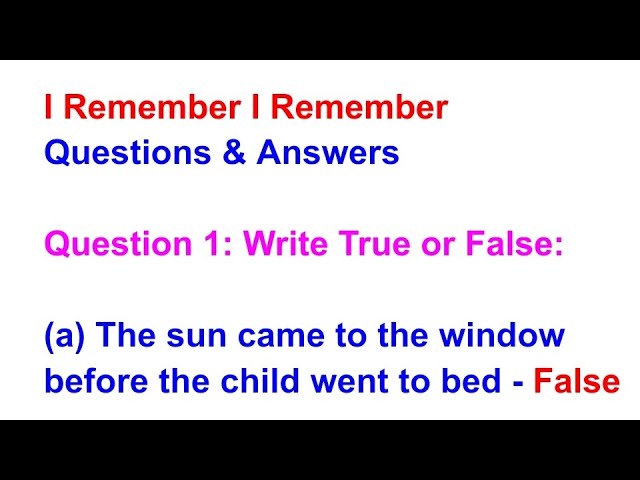The poem “I Remember, I Remember” by Thomas Hood is a nostalgic reflection on childhood memories, particularly the simplicity and joy of life during those early years. It presents a stark contrast between the idealized memories of youth and the adult realization that these moments are no longer attainable. In this article, we will explore the poem in detail, examining its themes, literary devices, and providing a set of questions and answers to aid in a better understanding of the poem.
Overview of the Poem
Thomas Hood’s “I Remember, I Remember” expresses the poet’s longing for the carefree days of his childhood. Through the poem, Hood conveys the sadness of realizing that the innocent happiness and freedom of youth are lost as one grows older. The poet’s memory of the past is filled with imagery of beauty and simplicity, but it is now overshadowed by the realities of adult life. The poem speaks to the universal experience of growing up and the inevitable changes that come with time.
The poem is written in the first person, which gives it a personal and reflective tone. It consists of several stanzas, each dealing with the poet’s recollections of his childhood, his observations of the landscape, and the bittersweet feelings that accompany these memories.
Summary of the Poem
The speaker in “I Remember, I Remember” begins by recalling the place of his childhood, describing it with great fondness. The imagery of “the green hills,” “the morning’s early light,” and the sense of freedom and joy are all symbolic of the poet’s idyllic youth. However, as the poem progresses, the tone shifts from nostalgia to a sense of loss. The speaker reflects on how the place that once brought him joy now seems distant and unreachable. The poem ends with the realization that while childhood memories can never be recaptured, they continue to haunt the adult mind with both joy and sorrow.
Themes in the Poem
- Nostalgia and the Passage of Time: One of the central themes of “I Remember, I Remember” is the passage of time. The speaker longs for the simplicity and joy of childhood, but as an adult, he is confronted with the inevitable changes that time brings. The poem reflects a common human experience: the desire to return to a more innocent, carefree time.
- Memory and Loss: The poem explores the idea of memory and the fleeting nature of youth. As the speaker recalls the past, he is reminded of the things he can no longer have—such as the freedom and beauty of childhood. The theme of loss is prominent throughout the poem as the speaker comes to terms with the fact that the world he remembers has changed.
- Contrast between Youth and Adulthood: The poem draws a sharp contrast between the speaker’s childhood and adulthood. While his childhood was full of happiness and light, adulthood is marked by a sense of loss and disillusionment. This contrast underscores the idea that the passage of time brings both gains and losses, and the joy of youth is something that cannot be fully recaptured.
- The Power of Nature: The imagery of nature in the poem—such as the “green hills” and the “morning’s early light”—is used to symbolize the purity and beauty of childhood. Nature is portrayed as a source of joy and freedom, and it contrasts with the more complicated and less joyful adult world.
Literary Devices Used in the Poem
- Imagery: The poem is rich in imagery that helps to create a vivid picture of the speaker’s childhood. Phrases like “green hills,” “morning light,” and “garden green” evoke a sense of peace and natural beauty. This imagery also emphasizes the contrast between the speaker’s memories and his present reality.
- Personification: In the poem, Hood uses personification to give human qualities to the natural world. For example, he writes that “the hills looked down in love,” which gives the impression that nature itself is capable of feeling and expressing affection.
- Alliteration: The poet uses alliteration in several places, such as in the line “the sun was hot.” This repetition of consonant sounds contributes to the poem’s musicality and rhythm.
- Rhyme and Meter: The poem follows a regular rhyme scheme, which adds to its lyrical quality. The meter of the poem is also steady, which reflects the gentle and reflective nature of the speaker’s musings.
Poem Analysis with Questions and Answers
To help deepen your understanding of “I Remember, I Remember,” we have provided a set of questions and answers based on the poem. These questions focus on key aspects such as themes, literary devices, and the meaning of the poem.
1. What is the central theme of the poem “I Remember, I Remember”?
- Answer: The central theme of the poem is the passage of time and the feeling of nostalgia. The speaker reflects on his childhood with longing and sadness, as he recognizes that the simple joys and freedom he once experienced are now lost to him as an adult.
2. How does the poet use imagery to convey the theme of nostalgia?
- Answer: The poet uses vivid imagery of nature, such as “green hills,” “garden green,” and “the morning light,” to evoke the innocence and beauty of childhood. These images represent a simpler time, and their use highlights the contrast between the past and the present.
3. What role does the imagery of nature play in the poem?
- Answer: Nature serves as a symbol of the speaker’s youthful happiness and innocence. The descriptions of the “green hills” and the “morning light” suggest the purity and freedom the speaker once experienced. Nature acts as a constant reminder of the lost joys of childhood.
4. What does the speaker mean when he says, “The hills looked down in love”?
- Answer: This is an example of personification, where the hills are given human qualities. The phrase “looked down in love” suggests that the natural world, in the speaker’s memories, was full of warmth, affection, and protection. It implies a sense of comfort and safety that the speaker associates with his childhood.
5. Why does the tone of the poem shift as it progresses?
- Answer: The tone shifts from nostalgic and idyllic to one of loss and sorrow as the speaker recalls how the beauty and simplicity of childhood are no longer present. The shift reflects the speaker’s realization that time has passed, and the innocence of youth can never be reclaimed.
6. How does the poem explore the idea of memory and loss?
- Answer: The poem examines memory by contrasting the speaker’s past experiences with his present reality. The memories of childhood are depicted as bright and beautiful, but they are also tinged with sadness because the speaker can never return to them. The theme of loss is evident as the speaker acknowledges the impossibility of recapturing those moments.
7. What is the significance of the title “I Remember, I Remember”?
- Answer: The title emphasizes the importance of memory in the poem. It suggests that the speaker is looking back on his past with fondness, but also with an understanding that memories, no matter how cherished, are ultimately fleeting.
8. What literary devices are used in the poem to enhance its emotional impact?
- Answer: The poem uses several literary devices, including imagery, personification, alliteration, and rhyme. These devices help create a vivid and emotional portrayal of the speaker’s memories. The repetition of certain sounds and the rhythm of the poem contribute to its reflective and melancholic tone.
9. What does the poem suggest about the inevitability of change?
- Answer: The poem suggests that change is an inevitable part of life. The speaker’s recollections of childhood show how time has altered both his surroundings and his emotional state. The realization that the past cannot be recaptured is a poignant reflection on the passage of time.
10. What is the mood of the poem?
- Answer: The mood of the poem is both nostalgic and sorrowful. The speaker reflects on the happiness of childhood, but there is also a sense of sadness and longing as he recognizes that those moments are gone forever.
Conclusion
“I Remember, I Remember” by Thomas Hood is a poignant meditation on the passage of time, memory, and loss. Through vivid imagery, personification, and careful use of rhyme and meter, Hood captures the bittersweet feelings that accompany the realization that childhood, with all its simplicity and beauty, is lost. The poem serves as a timeless reminder of the universal human experience of growing up and the inevitable changes that come with age. By examining the poem’s themes and literary devices, we gain a deeper appreciation for its exploration of the complexities of memory and the passage of time.
By engaging with the poem through the questions and answers provided, readers can gain a richer understanding of the emotions and ideas conveyed in Hood’s work, reflecting on their own memories and the effects of time on their lives.














